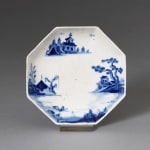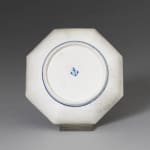

Extremely Rare Chelsea Blue and White Octagonal Saucer, Circa 1752
An Extremely Rare Chelsea Blue and White Octagonal Saucer with raised foot painted with an oriental landscape scene depicting a seated figure in the foreground angling fish on the bottom right of the cavetto. Left of the fishing rod, a lone figure rows a sampan along the hazy river which ripples beneath diametrically opposed islands, the left desolate features a willow tree while the right is painted with a pine tree and a two-storey pavilion. At the top left corner, flocks of birds in the distance fly overhead a spired two-storey pavilion tucked behind two hills. The exterior is painted with an underglaze blue ring along the footrim.
Where other English manufactories produced blue and white porcelain either replicating or competing against Chinese blue and white porcelain, Chelsea blue and white porcelain is extremely rare as the manufactory predominately produced ornamental wares which were decorated in overglaze polychrome enamels. Of this extremely rare example, Elizabeth Adams notes that only six surviving saucers with identical decoration are known. One is in the Colonial Williamsburg Foundation, Virginia. (1962-31), another is in the Katz Collection in the Museum of Fine Arts, Boston (67.1186). At least two others are known to be in Private Collections.
Interestingly, while Chelsea blue and white porcelain was rare, Sir Horace Walpole is known to have had a Chelsea blue and white dish which was displayed in the ‘China Room’ at his home Strawberry Hill.
Marks: Underglaze blue anchor mark
Provenance
Lady Hinsley Collection; Thence by descentLiterature
See F. Severne Mackenna, Chelsea Porcelain: The Red Anchor Wares (1951), pp. 82-83, pl. 1. See F. Severne Mackenna, Chelsea Porcelain: The Red Anchor Wares (1951), pp. 82-83, pl. 1. See further discussion in Elizabeth Adams, Chelsea Porcelain (2001), pp. 96-98, fig. 8.2. For the Williamsburg example, see John C. Austin, Chelsea Porcelain at Williamsburg (1977), cat. 48. For the Katz example, see Bernard Watney, English Blue and White Porcelain of the 18th Century (1963), pl. 1B.Join our mailing list
* denotes required fields
We will process the personal data you have supplied in accordance with our privacy policy (available on request). You can unsubscribe or change your preferences at any time by clicking the link in our emails.

